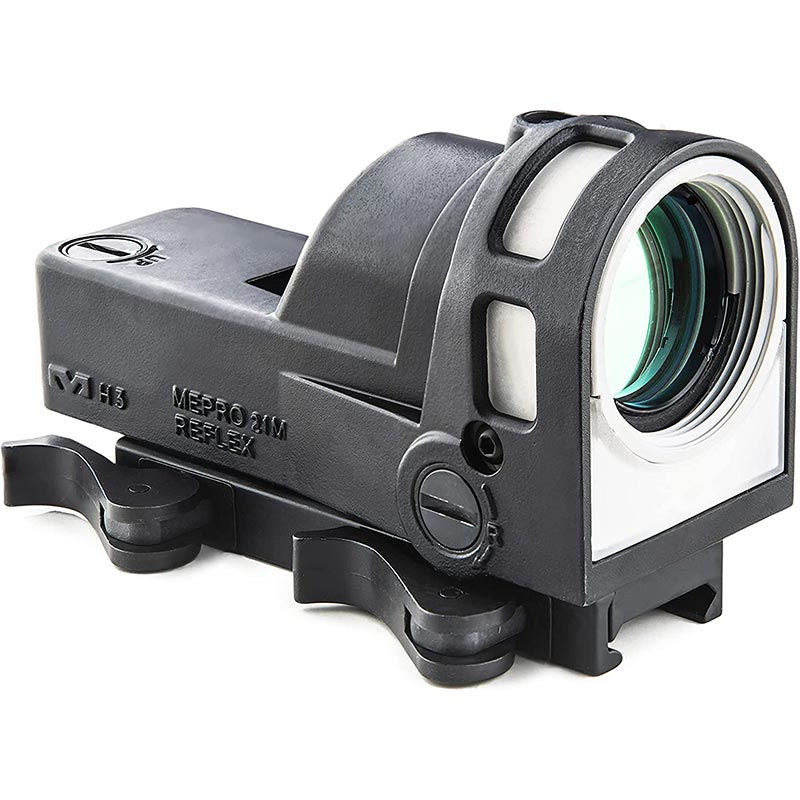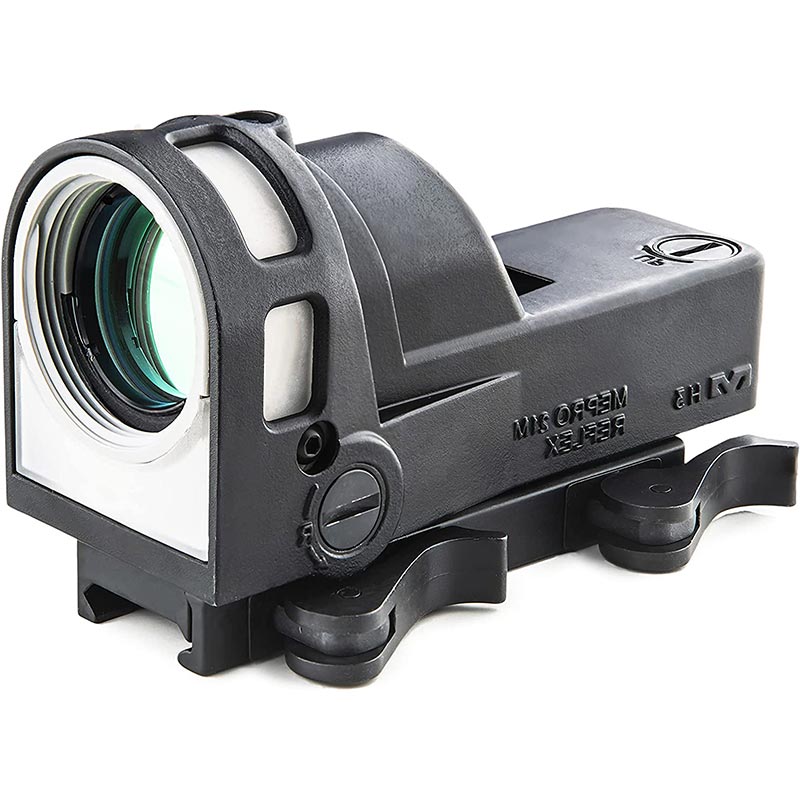Description
Mepro M21 Red Dot Self-Powered Day/Night Reflex Sight integrates advanced Meprolight® tritium technology for reliable performance in any lighting condition. This sight harnesses fiber optics during the day and switches to self-illuminating tritium at night, ensuring clear visibility without the need for batteries. The large 30mm lens provides a wide field of view, enabling rapid target acquisition. With five reticle options, it accommodates various tactical scenarios, enhancing both speed and accuracy.
Engineered to endure harsh environments, the M21 meets strict MIL-STD-810 standards for ruggedness and reliability. It’s also compatible with Night Vision Goggles and magnifying scopes, preserving targeting accuracy in low light. Weighing only 372 grains and featuring a compact design, this reflex sight is easy to mount and operate, making it an ideal choice for military, law enforcement, and civilian applications.
Features – Key Benefits Bullets
- SELF-ILLUMINATING TECHNOLOGY: Utilizes fiber optics by day and tritium at night, ensuring constant visibility without batteries.
- LARGE FIELD OF VIEW: 30mm diameter lens provides an expansive view for quick target acquisition.
- VARIETY OF RETICLES: Five reticle options, including MOA and Bullseye, allow customization for different shooting scenarios.
- RUGGED CONSTRUCTION: Built to MIL-STD-810 standards, this sight withstands extreme weather conditions and impacts.
- NIGHT VISION COMPATIBLE: Compatible with Night Vision Goggles, maintaining accuracy in low-light situations.
- BATTERY-FREE OPERATION: No need for batteries or switches, ensuring readiness in critical scenarios.
- LONG-LASTING ILLUMINATION: Tritium illumination lasts up to ten years, providing reliable performance in low light.
- PROFESSIONAL GRADE: Trusted by military and law enforcement agencies for its proven reliability and performance.
Technical Specifications
| Attachment/Mount Type: | Picatinny |
| Condition: | New |
| Included Accessories: | Dust Cover |
| Magnification: | 1 x |
| Objective Lens Diameter: | 30 mm |
| Length: | 114 mm, 4.48 in |
| Weight: | 372 grain |
| Eye Relief: | Range 10 - 600 mm |
| Tube Diameter: | 1.17 in |
| Weather Resistance: | Yes |
| Color: | Black |
| Water Resistant Mark: | 1 m |
| Objective Aperture: | 27 mm |
| Illumination Type: | Tritium, Fiber Optics |
| Height: | 70 mm, 2.73 in |
| Width: | 2.22 in, 55 mm |
| Parallax: | 0.25 |
| W/E Travel at 100 Yds: | +/- 35 MOA |
| Adjustment Click Value: | 1.7 MOA |
| Lens Material: | Optical Glass |
| Lens Finish: | Polished |
| Fabric/Material: | Metal |
| Operating Temperature: | Range -40 - 131 Fahrenheit |
| Optical Coating: | AR Coating |
| Light Transmission: | 50 % |
| Water Resistance Level: | Waterproof |
| Illumination Color: | Red |
What's in the Box?
- Dust Cover
Customer Reviews
"The M21 is a game changer for low-light conditions. The tritium is super bright!"
"Easy to mount and use. The variety of reticles helps in different scenarios."
"Built tough! I've used it in heavy rain, and it still performs flawlessly."
FAQ
Will this work on my rifle?
If your rifle has a flattop upper receiver with an M1913 picatinny rail, it will work perfectly. If not, you may need to use different hardware to mount the optic.
How does it handle recoil from larger calibers?
The M21 can handle the recoil from most firearms, but it is primarily designed for tactical rifles rather than shotguns. For optimal performance, use it on firearms that match its specifications.
How well does it work in complete darkness?
The tritium dot is visible in almost complete darkness, but visibility of the target may be limited. It is highly effective when paired with night vision devices like a PVS-14.
How long does the tritium last?
The tritium typically lasts 9 to 10
Our Guarantees
FREE Fast Shipping Over $99
Enjoy complimentary expedited shipping on all orders over $99.
Secure Payments
Shop with confidence using our encrypted payment processing.
High Quality or Money Back
Not satisfied with your purchase? We'll refund your money, no questions asked.
Top-Notch Support
Our expert team is available to answer all your questions and provide assistance.
What Our Customers Say
Optics Knowledge Center
Understanding Rifle Scope Basics
Magnification
Magnification refers to how much larger an object appears through the scope compared to the naked eye. Fixed power scopes have one magnification setting, while variable power scopes offer a range (e.g., 3-9x).
Objective Lens
The objective lens is the front lens that gathers light. Larger objective lenses (measured in mm) gather more light, providing brighter images in low-light conditions but add weight and require higher mounting.
Reticle
The reticle (crosshair) is the aiming point inside the scope. Modern scopes offer various reticle designs, from simple duplex crosshairs to complex ballistic reticles with holdover points for different distances.
Adjustments
Rifle scopes have turrets for windage (horizontal) and elevation (vertical) adjustments. These are measured in MOA (minutes of angle) or MRAD (milliradians) and allow precise aiming adjustments.
Proper Scope Mounting Guide
Select the Right Rings & Base
Choose rings that match your scope's tube diameter (typically 1", 30mm, or 34mm). Select a base compatible with your rifle's receiver. For heavy-recoiling rifles, opt for stronger mounts.
Install the Base
Clean the receiver and base thoroughly. Apply a small amount of blue Loctite to the screws. Attach the base to the receiver and torque the screws to manufacturer specifications.
Attach the Rings
Attach the bottom halves of the rings to the base. Place the scope in the rings and loosely attach the top halves. Don't fully tighten yet.
Set Eye Relief & Level
Position the scope for proper eye relief (3-4 inches) in your normal shooting position. Ensure the reticle is level using a scope leveling tool. Once positioned correctly, tighten the rings evenly in a cross-pattern.
Scope Zeroing Tips
Start Close
Begin zeroing at a shorter distance (25-50 yards) to ensure you're on paper before moving to your desired zero distance (typically 100 yards).
Use a Stable Rest
Always zero your rifle from a stable shooting position using a bench rest, sandbags, or a shooting rest to eliminate as much human error as possible.
Fire Groups
Fire 3-shot groups before making adjustments. This provides a more accurate representation of where your rifle is shooting than single shots.
Make Deliberate Adjustments
Know your scope's adjustment values (typically 1/4 MOA per click). If your group is 2 inches low at 100 yards, you'll need to adjust up 8 clicks (for a 1/4 MOA scope).
Confirm Your Zero
After making adjustments, fire another group to confirm your zero. Repeat the process until your point of impact matches your point of aim.
Document Your Settings
Once zeroed, record your settings including distance, ammunition used, and environmental conditions for future reference.
Optics Maintenance & Care
Cleaning Lenses
- Start by blowing or brushing away loose particles
- Use a lens pen or microfiber cloth for fingerprints
- For stubborn dirt, use lens cleaning solution (never household cleaners)
- Clean with gentle circular motions from center outward
Protecting Your Optics
- Always use lens caps when not in use
- Store in a dry place with silica gel packets
- Avoid extreme temperature changes
- Use a quality scope cover in harsh conditions
Regular Maintenance
- Check and tighten mount screws periodically
- Inspect O-rings and seals for damage
- Verify zero after rough handling
- Clean the exterior with a damp cloth
What to Avoid
- Never use fingers to touch lenses
- Avoid paper products (tissues, paper towels) on lenses
- Don't use acetone, alcohol, or household cleaners
- Never disassemble your scope (voids warranty)












